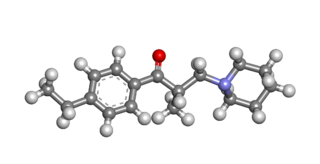Related Research Articles
Spasticity is a feature of altered skeletal muscle performance with a combination of paralysis, increased tendon reflex activity, and hypertonia. It is also colloquially referred to as an unusual "tightness", stiffness, or "pull" of muscles.
A muscle relaxant is a drug that affects skeletal muscle function and decreases the muscle tone. It may be used to alleviate symptoms such as muscle spasms, pain, and hyperreflexia. The term "muscle relaxant" is used to refer to two major therapeutic groups: neuromuscular blockers and spasmolytics. Neuromuscular blockers act by interfering with transmission at the neuromuscular end plate and have no central nervous system (CNS) activity. They are often used during surgical procedures and in intensive care and emergency medicine to cause temporary paralysis. Spasmolytics, also known as "centrally acting" muscle relaxant, are used to alleviate musculoskeletal pain and spasms and to reduce spasticity in a variety of neurological conditions. While both neuromuscular blockers and spasmolytics are often grouped together as muscle relaxant, the term is commonly used to refer to spasmolytics only.
Colloquially known as "downers", depressants or central depressants are drugs that lower neurotransmission levels, or depress or reduce arousal or stimulation in various areas of the brain. Depressants do not change the mood or mental state of others. Stimulants, or "uppers", increase mental or physical function, hence the opposite drug class from depressants are stimulants, not antidepressants.
Anticholinergics are substances that block the action of the acetylcholine (ACh) neurotransmitter at synapses in the central and peripheral nervous system.

Abdominal pain, also known as a stomach ache, Is a symptom associated with both non-serious and serious medical issues. Since the abdomen contains most of the body's vital organs, it can be an indicator of a wide variety of diseases. Given that, approaching the examination of a person and planning of a differential diagnosis is extremely important.

Carisoprodol, sold under the brand name Soma among others, is a medication used for musculoskeletal pain. Use is only approved for up to three weeks. Effects generally begin within half an hour and last for up to six hours. It is taken orally.

Dicycloverine, also known as dicyclomine, sold under the brand name Bentyl in the US, is a medication that is used to treat spasms of the intestines such as occur in irritable bowel syndrome. It is taken by mouth or by injection into a muscle. While it has been used in baby colic and enterocolitis, evidence does not support these uses.

Cyclobenzaprine, sold under the brand name Flexeril among others, is a muscle relaxer used for muscle spasms from musculoskeletal conditions of sudden onset. It is not useful in cerebral palsy. It is taken by mouth.

Baclofen, sold under the brand name Lioresal among others, is a medication used to treat muscle spasticity such as from a spinal cord injury or multiple sclerosis. It may also be used for hiccups and muscle spasms near the end of life, and off-label to treat alcohol use disorder or opioid withdrawal symptoms. It is taken orally or by intrathecal pump. It is also sometimes used transdermally in combination with gabapentin and clonidine prepared at a compounding pharmacy.

Orphenadrine is an anticholinergic drug of the ethanolamine antihistamine class; it is closely related to diphenhydramine. It is a muscle relaxant that is used to treat muscle pain and to help with motor control in Parkinson's disease, but has largely been superseded by newer drugs. It is considered a dirty drug due to its multiple mechanisms of action in different pathways. It was discovered and developed in the 1940s.

Methocarbamol, sold under the brand name Robaxin among others, is a medication used for short-term musculoskeletal pain. It may be used together with rest, physical therapy, and pain medication. It is less preferred in low back pain. It has limited use for rheumatoid arthritis and cerebral palsy. Effects generally begin within half an hour. It is taken by mouth or injection into a vein.

Tizanidine, sold under the brand name Zanaflex among others, is an alpha-2 (α2) adrenergic receptor agonist, similar to clonidine, that is used to treat muscle spasticity due to spinal cord injury, multiple sclerosis, and spastic cerebral palsy. Effectiveness appears similar to baclofen or diazepam. It is taken by mouth.

Corvalol is a tranquilizer based on the herb valerian root, as well peppermint oil Mentha piperita and hop extract Humulus lupulus and the barbiturate phenobarbital, popular in Eastern Europe and the former Soviet Union as a heart medication. It is available as a transparent liquid with a characteristic strong aroma, and as white bi-concave scored tablets. While not available for sale in the Western countries, Corvalol is sometimes brought over from Eastern Europe for self-administration to other countries of residence. Corvalol contains documented amounts of psychoactive chemicals, and may interact with other prescription medications that a person is taking.
Hypertonia is a term sometimes used synonymously with spasticity and rigidity in the literature surrounding damage to the central nervous system, namely upper motor neuron lesions. Impaired ability of damaged motor neurons to regulate descending pathways gives rise to disordered spinal reflexes, increased excitability of muscle spindles, and decreased synaptic inhibition. These consequences result in abnormally increased muscle tone of symptomatic muscles. Some authors suggest that the current definition for spasticity, the velocity-dependent over-activity of the stretch reflex, is not sufficient as it fails to take into account patients exhibiting increased muscle tone in the absence of stretch reflex over-activity. They instead suggest that "reversible hypertonia" is more appropriate and represents a treatable condition that is responsive to various therapy modalities like drug or physical therapy.

Oxybutynin, sold as under the brand names Ditropan among others, is a medication used to treat overactive bladder. It works similar to tolterodine, darifenacin, and solifenacin. While used for bed wetting in children, evidence to support this use is poor. It is taken by mouth or applied to the skin.
Chlordiazepoxide/clidinium bromide is a fixed-dose combination medication used to treat peptic ulcers, irritable bowel syndrome (IBS), and gastritis. It contains chlordiazepoxide and clidinium bromide. It helps relieve stomach spasms, abdominal cramps, and anxiety related to gastric disorders. Librax is a fixed ratio of these two medications and, as such, is not typically prescribed with an accompanying dosage, but rather directions on how many capsules to take per day. It comes in a capsule taken by mouth, usually three or four times daily, before meals and at bedtime. Chlordiazepoxide is an anti-anxiety medication belonging to the benzodiazepine class. Its use in IBS is thought to be due to its calming ability for patients that have IBS symptoms that are worsened by anxiety. Clidinium bromide is a synthetic quaternary ammonium antimuscarinic, a sub-class of a family of drugs known as anticholinergics. It treats IBS by decreasing gastrointestinal motility.

Eperisone is an antispasmodic drug.

Mebeverine is a drug used to alleviate some of the symptoms of irritable bowel syndrome. It works by relaxing the muscles in and around the gut.
Donnatal is a combination medication that provides natural belladonna alkaloids in a specific fixed ratio combined with phenobarbital to provide peripheral anticholinergic/antispasmodic action and mild sedation. Donnatal is manufactured for Concordia Pharmaceuticals by IriSys, LLC. It is available as tablets and 5 mL elixir. Active ingredients are listed as: phenobarbital (16.2 mg), hyoscyamine sulfate (0.1037 mg), atropine sulfate (0.0194 mg), and scopolamine hydrobromide (0.0065 mg). The latter two ingredients are found in plants of the family Solanaceae, such as belladonna.
An analgesic adjuvant is a medication that is typically used for indications other than pain control but provides control of pain (analgesia) in some painful diseases. This is often part of multimodal analgesia, where one of the intentions is to minimize the need for opioids.
References
- ↑ "Antispasmodic". thefreedictionary.com. Retrieved February 1, 2016.
- ↑ Hadley, S. K.; Gaarder, S. M. (2005). "Treatment of irritable bowel syndrome". American Family Physician. 72 (12): 2501–6. PMID 16370407.
- ↑ Liu JK, Couldwell WT (2005). "Intra-arterial papaverine infusions for the treatment of cerebral vasospasm induced by aneurysmal subarachnoid hemorrhage". Neurocritical Care. 2 (2): 124–132. doi:10.1385/NCC:2:2:124. PMID 16159054. S2CID 35400205.
- ↑ "Colofac Tablets 135mg - Summary of Product Characteristics (SPC)". UK Electronic Medicines Compendium. 26 August 2016. Retrieved 21 July 2017.
- ↑ Pittler, M.H.; Ernst, E. (1998). "Peppermint oil for irritable bowel syndrome: A critical review and metaanalysis". The American Journal of Gastroenterology. 93 (7): 1131–5. PMID 9672344.
- ↑ Hiki, Naki; Kurosaka, Hanzou; Tatsutomi, Yusuke; Shimoyama, Shouji; Tsuji, Eiichi; Kojima, Junichi; Shimizu, Nobuyuki; Ono, Hitoshi; Hirooka, Tatsuo; Noguchi, Chiaki; Mafune, Ken-Ichi; Kaminishi, Michio (2003). "Peppermint oil reduces gastric spasm during upper endoscopy: A randomized, double-blind, double-dummy controlled trial". Gastrointestinal Endoscopy. 57 (4): 475–82. doi:10.1067/mge.2003.156. PMID 12665756.
- 1 2 3 Chou, Roger; Peterson, Kim; Helfand, Mark (2004). "Comparative efficacy and safety of skeletal muscle relaxants for spasticity and musculoskeletal conditions: A systematic review". Journal of Pain and Symptom Management. 28 (2): 140–75. doi: 10.1016/j.jpainsymman.2004.05.002 . PMID 15276195.
- 1 2 "Skeletal Muscle Relaxants". medscape.com. Retrieved 27 January 2024.
- 1 2 Taricco, Mariangela; Adone, Roberto; Pagliacci, Christina; Telaro, Elena (2000). "Pharmacological interventions for spasticity following spinal cord injury". Cochrane Database of Systematic Reviews (2): CD001131. doi:10.1002/14651858.CD001131. PMC 8406943 . PMID 10796750.
- ↑ Shakespeare D, Boggild M, Young CA. Anti-spasticity agents for multiple sclerosis. Cochrane Database of Systematic Reviews 2003, Issue 4. Art. No.: CD001332. doi : 10.1002/14651858.CD001332.